"the tubercles channel the wind as it hits the front or "leading" edge of the blade. The channels cause separate wind streams to accelerate across the surface of the blade in organized, rotating flows. These energy-packed vortexes seem to increase the lift force on the blade.
As well, the channels prevent airflow from moving along the span of the blade and past its tip, a troubling situation on smooth blades that can cause noise, instability and lead to a loss of energy. By keeping the airflow channelled, more of the wind is captured and noise is greatly reduced."
http://www.thestar.com/article/213475
I am thinking that this could also be applied to the front and rear wings of an F1 car to help in reducing drag and potentially increasing downforce.... now if only movable aerodynamics were allowed, they could put turning vanes on the car too
My apologies if this has already been discussed or developed... I recall seeing saw-tooth edges on the trailing edge of wings but never on the leading edge.




